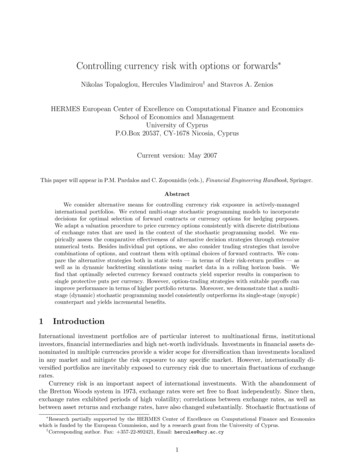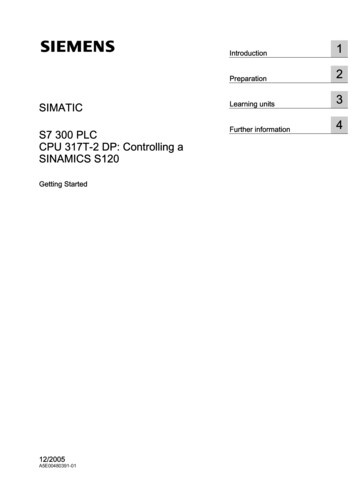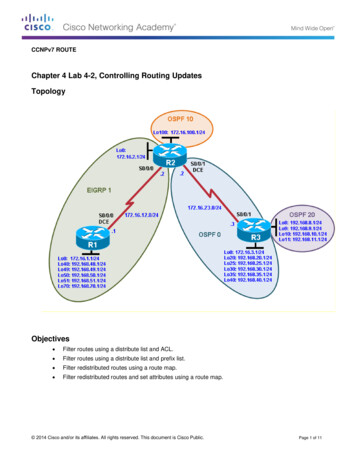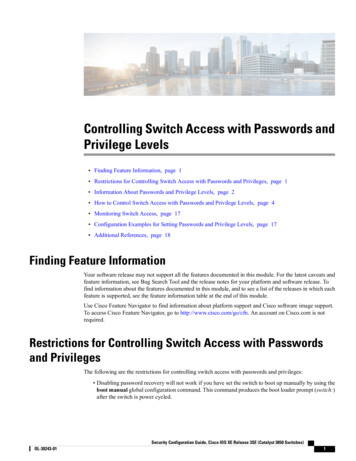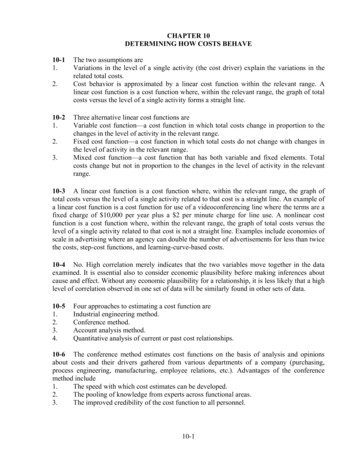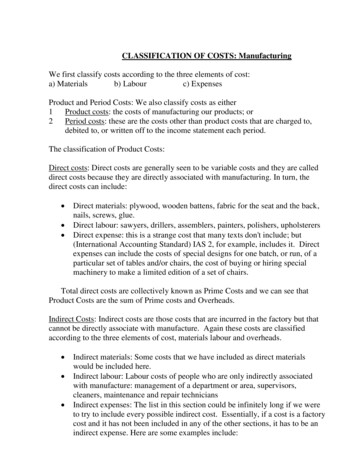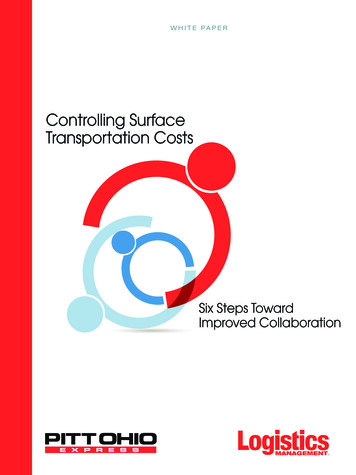
Transcription
WHITE PAPERControlling SurfaceTransportation CostsSix Steps TowardImproved Collaboration
Controlling Surface Transportation CostsSix Steps Toward Improved CollaborationTrucking networks are complicated matrixes of equipment, driveravailability, and capacity alllayered by service requirementsand costs. The best truckingoperators are the ones that can best match up theiravailable capacity with enough freight to make theirnetworks run in balance—or as close to 100 percentfull in both the headhaul and backhaul lanes.Cost pressures are rising for all truckingcompanies. A new Class 8 truck costs around 125,000, an increase of nearly 40 percent overthe past five years. Fuel, insurance, terminalreal estate, driver pay and healthcare costs areall increasing at alarming rates. Even the mostefficient carriers are not immune from a bevy offactors affecting their internal costs.Besides labor and equipment, trucking fleetsare facing what U.S. Chamber of CommercePresident and CEO Thomas Donohue calls a“tsunami” of new, tough safety regulations thatmostly concern truck driver hours of service(HOS) and availability.Noel Perry, an economist with freightforecasting firm FTR Associates, estimates thecurrent driver shortage at around 100,000, butwarns that number could double in upcomingyears due to increased driver standards, mandatory drug and alcohol testing, greater scrutiny ofdrivers’ records, and aging demographics.The bottom line is that driver pay has beenrising, and is expected to continue; and due tothe recent changes in driver hours of service andnew laws requiring electronic logging of drivermiles driven, driver productivity is decreasing.In short, it’s going to take more drivers to handlewhat the American Trucking Associations (ATA)predicts will be a surge in surface transportationvolumes through 2020 and beyond.Importance of shipper/carriercollaborationFreight forecasting firm IHS Global Insightpredicts that trucking’s share of total tonnage willrise gradually to 70.9 percent by 2020. Despiteslight growth in rail and intermodal traffic, nearly1W W W. P IT TOH IO . CO M80 percent of all U.S. communities areserved exclusively by truck.While carriers can try to pass onsome of these higher operating coststo customers, the cutthroat marketplace will simply not allow anythingclose to double-digit percentage rateincreases. So, the key to controllingcarrier costs, and therefore shippers’trucking rates is increasing the levelof collaboration between the shipperand carrier.Increasingly, the truck is becoming the last,vital link in a shipper’s ever-dynamic supply chainoperation. Without timely deliveries, the shipper’s supply chain operation can literally come toa halt. Today, trucks are carrying inventory thatwas formerly housed in expensive warehousesand are now making multiple deliveries—oftenon the same day—to keep these efficient supplychains humming.“I would say that the best trucking operatorsare morphing into supply chain optimizers forshippers,” says John Larkin, the veteran truckinganalyst for investment banking firm Stifel Inc.“They are now offering all the services a customer may need to run an efficient supply chain.”Whether it’s full truckload (TL), partialless-than-truckload (LTL), intermodal, or somecombination of all three, shippers can take proactive steps to better control their surface transportation costs—steps that can transform a shipper’stransportation operation and improve their carrierrelationships across the board.In our current environment of ever-tighteningcapacity, shippers who are collaboratively working with their carriers are nearly certain to getpriority when it comes to peak periods of freightdemand.Unlike, say, the personal computing industrywhere innovations breed lower cost and higherquality, trucking’s costs are on a perennial uptick.But shippers have a huge say in how they fit intoa carrier’s cost structure.“The only way shippers can get better serviceis through carriers getting more productivity outof their work force,” says Satish Jindel, principalof Pittsburgh-based SJ Consulting, which closelytracks trucking industry trends. “This industry is
Controlling Surface Transportation CostsSix Steps Toward Improved Collaborationvery labor-, equipment- and fuel-intensive. Thosecosts are only going up and shippers need to takeevery step they can to help them.”So, let’s examine six ways that shippers canhelp their carriers mitigate these costs and gainthe additional rewards of better service, lowerrates, and a shared gain in efficiencies.Six steps toward improvedcollaborationThat 100 percent figure is a goal, of course. Inreality, most carriers don’t nearly fill all of theirtrucks all of the time; however, the most efficientoperators come close. And with the help of theirshipper customers, they can increase that loadfactor to help mitigate some of these rising costpressures.“There are a lot of inefficiencies in transportation networks,” says analyst Jindel. “The onlyway to eliminate them is a collaborative effortbetween shippers and carriers, and that requireselaborate, customer-friendly information sharingwith a level of trust.”If done correctly, Jindel says that it can resultin a “win-win-win” for all three key players in thesupply chain, meaning: Carriers gain great efficiencies throughbetter use of their network through the mosteffective use of equipment, driver availability,and network design; shippers save money through lower freightrates, better handling of their freight, lowerclaims, and better service; and consignees receive the freight in a moreorderly time frame with predictable deliveries atthe most opportune time.Let’s dive into the six areas where shippersand carriers can work collaboratively to drivedown a carrier’s cost, increase levels of service,and mitigate or even lower truck rates.1Consider mode and laneoptimizationMode and lane optimization are key steps inimproved collaboration. Simply put, that modeoptimization means putting the right-sizedshipment in the right-sized mode, whether it beLTL, TL, or intermodal. The other constrainthere is speed. If a shipment doesn’t have to be2W W W. P IT TOH IO . CO Mthere right away, carriers would advise shipping itintermodal—provided rail service is adequate.However, carriers and shippers don’t always dowhat’s best. Instead, they do what’s easiest. Shipments that are considered “in between” and couldgo TL often wind up on more costly LTL trucks.Freight that could go long-haul on an intermodalrail line haul end up in truck trailer further straining equipment and driver availability.Shippers are advised to know their minimumcharges, and be aware that your freight ratevaries by distance. In this case, it pays to be morescientific and analytical in your choice of modes.If it’s a very small box, consider going with apackage carrier instead of LTL.The same applies for heavyweight shipmentsbetween 8,000 pounds and 12,000 pounds. Howdense is that shipment? Instead of an LTL move,can several shipments be combined with othershippers’ freight to produce, say, a three-stop TLdelivery solution to eliminate costly destinationhandling costs.“It’s just a better use of resources,” says GeoffMuessig, executive vice president and chiefmarketing officer for Pittsburgh-based Pitt Ohio,a major trucking and transportation servicesprovider. “Put the right-size shipment on theright-size truck.”Lane optimization means understanding where the carrier has an imbalance. Somecarriers are looking for business and will offermore attractive rates on certain geographic lanes;however, it’s important that shippers realize thatnot all carriers have the same imbalance on thesame lanes.Pitt Ohio, for example, has a lot of legacybusiness in and out of its Pittsburgh base. UPSFreight, which was founded as Overnite Trucking in Richmond, Va., on the other hand, runs alot of freight in and out of Virginia. What worksmost efficiently for Pitt Ohio’s network might bedifferent than what fits best into UPS Freight’snetwork.The best advice is for shippers to optimizeby lane, not by convenience. While it might beeasier to give all your freight to one carrier, thatactually may not be the most efficient decision—it may actually be increasing that carrier’s costs.Shippers should also consider fully leveraging
Controlling Surface Transportation CostsSix Steps Toward Improved Collaborationtheir transportation management systems (TMS)to assign freight most efficiently for lane optimization and use the technology to create economies of scale at time of pickup.It’s probably a mistake to assign 10 differentshipments to 10 different carriers—that is shortsighted. While it may save some pennies today,it could cost big dollars in a shipper’s long-termfreight rates due to the costs associated withsingle shipment pickups.In short, know your carriers’ lane imbalances,as well as their wants and needs before you makeyour routing decisions2Improve your carrierrelationsThe more a shipper can relax the constraints overhow and when a shipment is picked up and thegreater efficiency the carrier can have. In truth,not everything has to be moved in a next-day delivery window. While a carrier can deliver freightby 10 a.m. the next day, the reality is that carrier’scost is inevitably going to rise through such tightdelivery constraints.“Faster shipping almost always requires highercosts,” says Jindel. “It’s just an airplane costsmore than driving. Shippers need to be cognizantHarry & David arrives at a sweet transportation solutionIn logistics and transportation, there are basically twotypes of business relationships—transactional and longer-term partnerships.As the complexity and demand of surface transportgrows, and the supply of adequate capacity tightens, bothcarriers and shippers say that there are huge long-termbenefits from eschewing transactional business for longer-term relationships. They also say that these relationships often pay immediate and substantial benefits.“Relationships matter,” says Jeff Brady, director oftransportation and logistics for Harry & David, the iconicspecialty gift and fruit retailer based in Medford, Ore.Brady was introduced to Pitt Ohio through his relationship with a less-than-truckload (LTL) carrier that wasalso part of the “Reliance Network,” an eight-carrierLTL network of regional carriers that have linked up toprovide seamless national and Canadian LTL service.In 2008, while working at Petco Animal Supplies,Brady had a truckload need in the Pennsylvania area,near Pitt Ohio’s home base. Brady met with Pitt Ohioofficials and the two parties took a deep dive into Petco’struckload challenges and needs. Following the meeting,he found that Pitt Ohio’s ECM truckload division met hisneed, and Brady went to work building the relationship forthe long term.When he shifted over to Harry & David in 2013, Bradyneeded assistance with multi-stop truckload retail deliveries to a portion of its 85 retail stores. He recalled that PittOhio filled that gap in his previous position, so he madethe call.“Right away they offered the ability to do the multi-3W W W. P IT TOH IO . CO Mstop truckload that I needed—and could do so within therequirements I was outlining in detail,” Brady says.Brady needed to implement pool distribution of someof Harry & David’s store freight in the middle of its busiestholiday season; and he did so by forming optimized truckload moves from its Ohio distribution center to a specificpopulation of stores.This enabled Brady to minimize outbound truckloadexpense and add scalability to Harry & David’s retaildelivery network by combining Pitt Ohio’s LTL and ECMtruckload services. ECM hauled the truckload lane to PittOhio’s LTL terminals and then broke down the freight fordistribution within Pitt Ohio’s traditional LTL network.“This was Pitt Ohio’s core competency,” says Brady,“and we worked together to make sure the moves madesense for both parties.”According to Brady, the relationship worked due to thefact that both sides were open and honest. “I had lanespecific needs and they had empty miles and capacity intheir network. They, again, proved themselves with theirservice and communication.”The relationship has flourished as both parties collaborated on Harry & David’s outbound store schedulesto drive out cost and create efficiencies in the networkthrough peak season. The parties now visit on a regularbasis to tweak needs based on changes in store schedules and mutual requirements.“The relationship is very open and collaborative andthat breeds trust and mutual success,” Brady says. “We’llcontinue to focus on how to grow the partnership for thebetterment of both parties.”
Controlling Surface Transportation CostsSix Steps Toward Improved Collaborationof that fact when they ask for faster service.”If a shipper can relax those constraints andgive the carrier increased flexibility in how andwhen that freight is delivered, operating costsand rates can decline dramatically. With thetechnology available today, many shipments aremoving at faster speeds than consignees actuallyneed. If a consignee doesn’t need delivery untilthree days from now, don’t ask for next-day delivery. In short, ship it when they need it, not whenthey want it.Jeff Brady has been a user of Pitt Ohio freightservices for nearly a decade, both at Petco andnow as director of transportation and logistics forHarry & David, the specialty fruit and gift retailer.“Pitt Ohio and its ECM [truckload division]were both very open and honest about theircapabilities,” Brady says. “I was honest in myapproach to committing to the process of helpingthem to help me. I had specific needs and theyhad empty miles in their network.”The result has been a win-win for Pitt Ohio andHarry & David. In store, on-time delivery performance has gone beyond Harry & David’s metricgoal of 97.5 percent, says Brady. “Having built asuccessful relationship previously with Pitt Ohioand being proactive about planning and forecastingreally helped us to help them be successful andmeet my needs this past holiday season,” he said.3Gain visibility intoshipment forecastsSharing a more accurate picture of shipmentforecasts allows carriers to plan their work schedules rather than simply showing up at a customer dock and being surprised by the volume ofshipments.If a carrier knows precisely what’s coming, itcan plan the appropriate resources for line-haulneeds in advance and optimize its resourcesthrough its entire network.Again, the airplane analogy comes to mind.Nobody makes a reservation with an airline andreserves the entire plane. Instead, we buy theone, two, or three seats that we need. The sameis true in trucking. Planning ahead saves money,as Harry & David discovered.“We collaborated on our outbound storeschedules to drive service and efficiencies,”4W W W. P IT TOH IO . CO MBrady explains. “Later we would re-visit on an annual basis to see if there were any changes in ourstores, DC operations, or in the carrier’s fleet. Wewould then tweak things on both sides collaboratively to drive mutual efficiencies and avoid rateincreases. The partnership was very open.”Jindel says that he would love to see the entireLTL industry be more proactive in telling shippers when precisely pickups and deliveries willbe made. UPS and FedEx do exactly that in thesmall package and parcel side of the business.In parcel freight, 95 percent of all parcel manifests are submitted electronically before that package is picked up. In LTL it’s about 30 percent. “IfLTL would get to 50 percent or 60 percent thatwould help carriers considerably,” Jindel adds.4Collaborate onrates5Minimize pickup anddelivery timesWhen shippers find ways to take costs out of acarrier’s network through easing constraints onshipments, they’re increasingly eligible to obtaingain-share savings with the carrier. Another wayto avoid annual rate increases is through multiyear contracts that provide slightly below-marketrates in return for long-term commitments forvolume and service.If carriers can plan on having that business forone, two, or three years they can optimize otherbusiness around your business. In nearly all cases,carriers say, shippers benefit from a carrier’s abilityto have a long-term, strategic partnership ratherthan a transactional one that comes and goes.It’s simply a matter of shippers being able totake a strategic view rather than a short-termtransactional view. Shippers must be moreinclined to take this approach in the marketwith driver availability tightening and othercostly restraints affecting service and rates. “Anyrelationship that works longer term is better thantransactional business,” Jindel adds.A truck driver is an extremely expensive resource.It’s estimated that a driver and his truck costs 100 per hour in the LTL sector—but that 100might be the low end of cost if a carrier is lookingat its actual opportunity cost.
Controlling Surface Transportation CostsSix Steps Toward Improved CollaborationDetaining that driver an extra hour couldactually cost much more than 100 if one looksat what other work that driver could have accomplished in that time. For example, if that driveris detained from, say, 5 p.m. to 6 p.m., he mighthave been unable to go to another location to fillthat truck.Now instead of operating a fully loaded truck,he returns to the terminal half full. The carriermight have to chase a lower-paying load to avoidreturning a leg of the trip empty—and the costjust snowballs. That certainly is the case if thedriver is detained during the peak late afternoonand mid-morning times.While Brady was working at Petco, the petspecialty retailer, he worked with Pitt Ohio andECM collaboratively to help the carrier fill emptymiles with its inbound traffic to its New Jerseydistribution center (DC). In essence, he was creating his own capacity for previously establishedoutbound lanes to stores with the same carrier.This collaboration led directly to improvedtrailer availability to vendors for his pickups,inbound service to the DC, and, in turn, on-timeloading and dispatch for outbound lanes. Doingthis collaboratively maximized Pitt Ohio’s useof its drivers and fleet and kept Petco’s costsvery competitive for the services and capacitiescommitted.“By creating this turn, we lane-matched andcapacity-matched,” Brady says. “This createdthe rate improvement and cut out unplannedaccessorial charges such as driver detention atour vendors and DCs. We collaborated with thestores to expedite a clean and on-time deliverynetwork. “Once this was accomplished, westarted to get down to helping each other andengraining ourselves with one another,” Bradyexplains. “It was the creation of a foundation of atrue partnership.”6Improved packagingand cratingWorking toward improving packaging and cratinghelps in two areas: reducing freight clams andimproved shipment density. If a shipper ismoving an uncrated piece of steel, for example,it raises the claims profile not only of that steelshipper, but other customers as well. That’s because that piece of uncrated steel could, perhaps,puncture another shipper’s hazardous materials,creating cleanup problems.Those types of shipments need to be crated,and that has to be done for each shipment of itskind. “It may cost that steel shipper 20 to 30 fora crate, but they will find that they save that muchor more in rates in the long term,” says Jindel.Improved packaging leads to improved shipment density, which can lead to better equipmentutilization and lower freight rates. If packages canbe double-stacked, do so. Create packaging that isthe most efficient use of trailer space, Jindel says.So despite relentlessly higher cost of operation by their carrier partners, shippers have ahuge say in creating the most efficient freightnetwork possible. Communication and collaboration are the keys. Then comes better planning,which allows carriers the most efficient use ofdrivers and equipment that ultimately leads tobetter load factors and fewer empty miles.All
are morphing into supply chain optimizers for shippers,” says John Larkin, the veteran trucking analyst for investment banking firm Stifel Inc. “They are now offering all the services a custom-er may need to run an efficient supply chain

